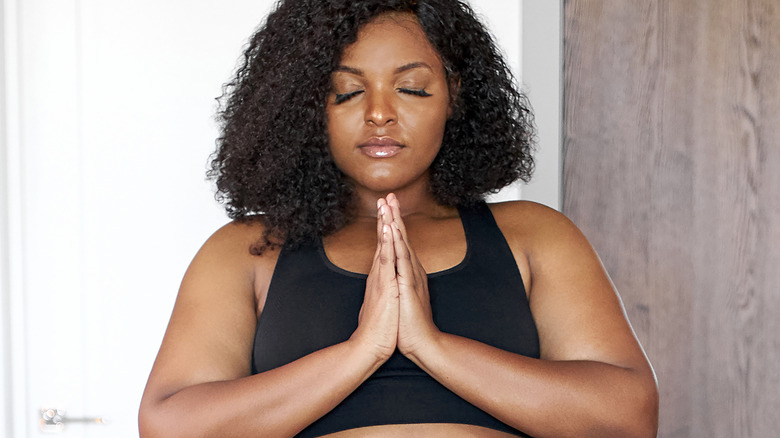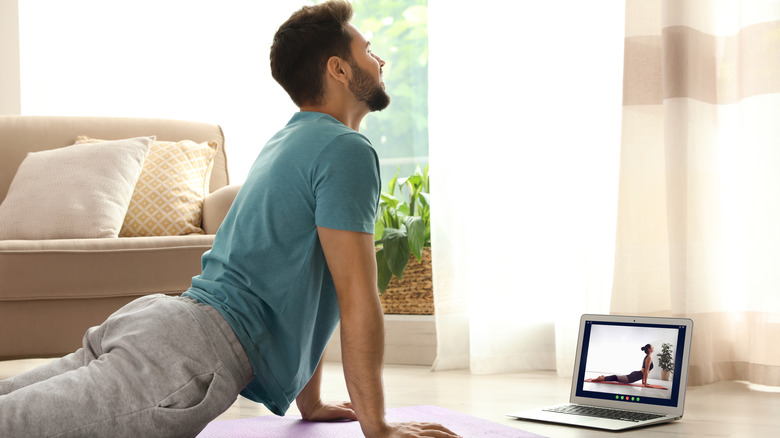How To Ease Yourself Back Into Working Out After Taking Time Off
Whether the COVID-19 pandemic took away your motivation or life's obligations were weighing you down, getting out of a workout routine can be frustrating. Now that summer is in full swing and people are leaving their homes more, it's a great time to set yourself up with a sustainable workout routine. After all, we know the best way to feel great is to move our bodies.
However ready you feel to get back to the gym, researchers warn against jumping back into strenuous weight lifting or heart-pumping cardio too soon (via Self). Experts agree that the best way to work yourself back into a healthy regimen is to start slowly and build up endurance. Jumping in too soon can be a detriment to your body emotionally and physically. So, how should you get back into the swing of things in terms of working out? There are many steps you can take to recommit to a healthy workout routine.
Laying the groundwork
Most of us know that jumping right back into the swing of things will not benefit us in the long run. Oftentimes, when people do that, they become frustrated with how much physical decline has occurred in their stagnant months. Self recommends establishing your fitness goals before diving back in. TIME goes even further, saying that visiting with your doctor is advisable before starting. Taking these careful steps will help you to make sure the goals you set for yourself are attainable and measurable.
By laying the groundwork before you begin, you'll have the motivation to achieve whatever goals you have set. Whether it be fitting into your favorite pair of jeans or being able to run a mile, if your goals are measurable, success is easier.
Set small goals at first
The worst thing you can do when getting back into working out is try to do too much. Start with 10 to 15-minute chunks of time for working out. When it comes to cardio, doctors recommend starting with 20 to 30 minutes of workouts that are moderate in intensity. According to Men's Health, you'll know you're on the right path when your breathing naturally gets heavier over time rather than becoming out of breath quickly or all at once.
As for resistance training, TIME suggests starting with body weight and gradually working up to lifting heavier weights. Doing any form of workout for any duration of time is better than nothing. So, set those small goals and enjoy the feeling you get when you exceed them.
Safety is key
Like any endeavor you take on, safety is the most important aspect. If you start working out too hard and hurt yourself, you risk putting yourself back even further than you were when you were taking your break. Self explains that after two weeks of inactivity, your ability to sustain aerobic workouts declines.
In addition, taking a break from strength training causes your muscle mass to decline, so try to lift the same weight as when you were lifting consistently. Those who want to jump back into working out should take these things into consideration when planning their schedule. Likewise, allow for time before and after the workout for proper warm-up and cool-down exercises.
Set a schedule and a motivation
Along with discussing your exercise goals with a doctor, setting a schedule for the week ahead is a great way to stay motivated. While scheduling, think about the most optimal time of day for you to complete a 30-minute workout. DIY Active notes that you should consider diversifying your workouts to keep things interesting.
The more excited you are to complete a workout, the more likely you are to keep this schedule going. Adding a mixture of HIIT workouts, cardio, and strength training will help you bust through plateaus and meet those goals head-on. Consider getting a workout partner either in person or virtually to hold you accountable. This will make you show up more regularly and provide more fun while getting into shape.
Take time to rest
Starting slow is great advice to take, but also make sure to not schedule too many workout days in a row. Your body benefits from rest, too. On your off days, try some simple stretches or yoga to increase mobility. Other low-impact activities for active recovery include going for a walk or a hike. These rest days will still benefit you physically but can make such a difference mentally as well (via Self). When you're well-rested, you're more likely to look forward to the workouts that include cardio and weight training.
We all know moving our bodies is fundamentally important to living a happy and long-lasting life. It's important to focus on your own goals and not compare your journey with another person's. Just because we go through setbacks, it doesn't mean we have to be stagnant forever. Our bodies are constantly changing and wildly forgiving. Instead of thinking of all of the excuses you can not to start moving again, reshape your thinking into celebrating what your body can do. There's never been a better time to get active.





